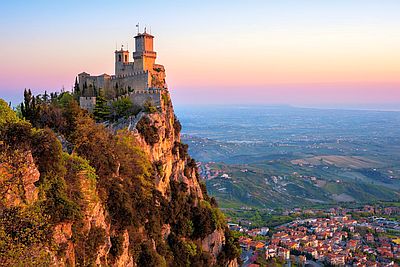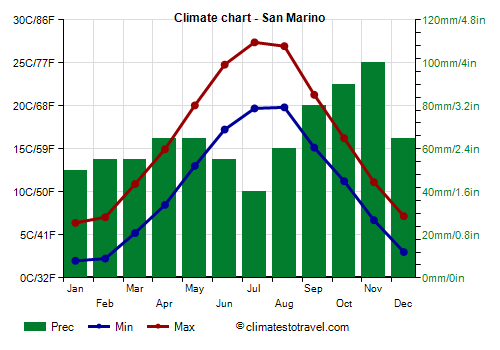Select units of measurement for the temperature and rainfall tables (metric or imperial).
Average weather, temperature, rainfall, sunshine
The climate of San Marino is
temperate, with quite cold winters and warm to hot summers.
The small Republic of San Marino is located between Marche and Emilia-Romagna, two regions of north-central Italy.
The
altitude varies from 55 meters (180 feet) in the north-east to 749 meters (2,457 ft) on the top of Mount Titano. The weather station is located at 680 meters (2,230 ft).
In the
lower part, summers are hot and muggy, and the climate resembles that of
Rimini.
In winter, during outbreaks of
cold air from the north-east, snowfalls can occur, sometimes abundant. Snow is more frequent above 400 meters (1,300 ft). During some winters, snowfalls can be particularly abundant. In February 2012, as high as 2 meters (79 inches) of snow fell, even on the lowland.
The cold record is -13 °C (8.5 °F), set in February 1956. The heat record is 40 °C (104 °F), set in July 1983.

The climate in detail
Temperature and rain

The
average temperature of the coldest month (January) is of 4.2 °C (40 °F), that of the warmest month (July) is of 23.6 °C (74 °F).
Precipitation amounts to 770 millimeters (30.3 inches) per year: so, it is at an intermediate level. It ranges from 40 mm (1.6 in) in the driest month (July) to 100 mm (3.9 in) in the wettest (November).
Weather by month
(based on the period 1991 - 2020).
In
January, the coldest month of the year, the average temperature is 4.2 °C (39.6 °F), with a minimum of 2 °C (35.6 °F) and a maximum of 6.4 °C (43.5 °F).
On the coldest nights of the month, the temperature typically drops to -4 °C (25 °F). However, it dropped to -9 °C (16 °F) in January 2006.
On the mildest days of the month, the temperature typically reaches 13.5 °C (56 °F). However, it reached 20 °C (68 °F) in January 2000.
Precipitation amounts to 50 millimeters (2 inches), spread over 6 days.
In
February, the average temperature is 4.7 °C (40.4 °F), with a minimum of 2.3 °C (36.1 °F) and a maximum of 7.1 °C (44.7 °F).
On the coldest nights of the month, the temperature typically drops to -3.5 °C (26 °F). However, it dropped to -12.5 °C (10 °F) in February 1991.
On the mildest days of the month, the temperature typically reaches 14.5 °C (58 °F). However, it reached 20 °C (68 °F) in February 1998.
Precipitation amounts to 55 millimeters (2.2 inches), spread over 7 days.
In
March, the average temperature is 8.1 °C (46.5 °F), with a minimum of 5.2 °C (41.4 °F) and a maximum of 10.9 °C (51.7 °F).
On the coldest nights of the month, the temperature typically drops to -1 °C (30 °F). However, it dropped to -9 °C (16 °F) in March 2005.
On the mildest days of the month, the temperature typically reaches 19 °C (66 °F). However, it reached 24.5 °C (76 °F) in March 2001.
Precipitation amounts to 55 millimeters (2.2 inches), spread over 7 days.
In
April, the average temperature is 11.7 °C (53.1 °F), with a minimum of 8.5 °C (47.3 °F) and a maximum of 15 °C (58.9 °F).
On the coldest nights of the month, the temperature typically drops to 2 °C (36 °F). However, it dropped to -2.5 °C (28 °F) in April 1991.
On the warmest days of the month, the temperature typically reaches 22.5 °C (72 °F). However, it reached 30 °C (86 °F) in April 2000.
Precipitation amounts to 65 millimeters (2.6 inches), spread over 9 days.
In
May, the average temperature is 16.5 °C (61.8 °F), with a minimum of 13 °C (55.4 °F) and a maximum of 20.1 °C (68.1 °F).
On the coldest nights of the month, the temperature typically drops to 7 °C (44 °F). However, it dropped to 1 °C (34 °F) in May 1991.
On the warmest days of the month, the temperature typically reaches 27.5 °C (81 °F). However, it reached 32 °C (90 °F) in May 2001.
Precipitation amounts to 65 millimeters (2.6 inches), spread over 8 days.
In
June, the average temperature is 21 °C (69.8 °F), with a minimum of 17.3 °C (63.1 °F) and a maximum of 24.8 °C (76.6 °F).
On the coldest nights of the month, the temperature typically drops to 11 °C (52 °F). However, it dropped to 6.5 °C (44 °F) in June 1991.
On the warmest days of the month, the temperature typically reaches 31.5 °C (88 °F). However, it reached 35.5 °C (96 °F) in June 2002.
Precipitation amounts to 55 millimeters (2.2 inches), spread over 5 days.
In
July, the warmest month of the year, the average temperature is 23.6 °C (74.4 °F), with a minimum of 19.7 °C (67.5 °F) and a maximum of 27.4 °C (81.3 °F).
On the coldest nights of the month, the temperature typically drops to 13 °C (55 °F). However, it dropped to 10 °C (50 °F) in July 2007.
On the warmest days of the month, the temperature typically reaches 33 °C (91 °F). However, it reached 37 °C (99 °F) in July 2000.
Precipitation amounts to 40 millimeters (1.6 inches), spread over 4 days.
In
August, the average temperature is 23.4 °C (74.1 °F), with a minimum of 19.8 °C (67.7 °F) and a maximum of 26.9 °C (80.5 °F).
On the coldest nights of the month, the temperature typically drops to 13.5 °C (56 °F). However, it dropped to 7 °C (45 °F) in August 1995.
On the warmest days of the month, the temperature typically reaches 32.5 °C (90 °F). However, it reached 36 °C (97 °F) in August 2017.
Precipitation amounts to 60 millimeters (2.4 inches), spread over 5 days.
In
September, the average temperature is 18.2 °C (64.8 °F), with a minimum of 15.2 °C (59.3 °F) and a maximum of 21.3 °C (70.3 °F).
On the coldest nights of the month, the temperature typically drops to 9.5 °C (49 °F). However, it dropped to 6 °C (42 °F) in September 2007.
On the warmest days of the month, the temperature typically reaches 27.5 °C (81 °F). However, it reached 31 °C (88 °F) in September 2003.
Precipitation amounts to 80 millimeters (3.1 inches), spread over 7 days.
In
October, the average temperature is 13.8 °C (56.8 °F), with a minimum of 11.3 °C (52.3 °F) and a maximum of 16.2 °C (61.2 °F).
On the coldest nights of the month, the temperature typically drops to 5.5 °C (42 °F). However, it dropped to 0.5 °C (33 °F) in October 1991.
On the warmest days of the month, the temperature typically reaches 23 °C (73 °F). However, it reached 27.5 °C (81 °F) in October 1999.
Precipitation amounts to 90 millimeters (3.5 inches), spread over 8 days.
In
November, the average temperature is 8.9 °C (48.1 °F), with a minimum of 6.7 °C (44.1 °F) and a maximum of 11.1 °C (52 °F).
On the coldest nights of the month, the temperature typically drops to 1 °C (33 °F). However, it dropped to -5 °C (23 °F) in November 2005.
On the mildest days of the month, the temperature typically reaches 18 °C (64 °F). However, it reached 23 °C (73 °F) in November 2004.
Precipitation amounts to 100 millimeters (3.9 inches), spread over 10 days.
In
December, the average temperature is 5.1 °C (41.2 °F), with a minimum of 3 °C (37.4 °F) and a maximum of 7.2 °C (44.9 °F).
On the coldest nights of the month, the temperature typically drops to -3.5 °C (26 °F). However, it dropped to -10 °C (14 °F) in December 1996.
On the mildest days of the month, the temperature typically reaches 13.5 °C (56 °F). However, it reached 18.5 °C (66 °F) in December 1999.
Precipitation amounts to 65 millimeters (2.6 inches), spread over 8 days.
When to go
To visit San Marino, you can choose the period
from mid-May to mid-June and the month of September.
In July and August, the heat is usually bearable, but it can be intense at times.
What to pack
In
winter: bring warm clothes, such as a sweater, a down jacket, a hat, gloves, a scarf, and a raincoat or umbrella.
In
summer: bring light clothing, a T-shirt, a sweatshirt or sweater, a light jacket, and a raincoat or umbrella.
Climate data - San Marino
| San Marino (680 meters) |
|---|
|
| Jan | Feb | Mar | Apr | May | Jun | Jul | Aug | Sep | Oct | Nov | Dec |
|---|
| Min temp. | 2 | 2 | 5 | 8 | 13 | 17 | 20 | 20 | 15 | 11 | 7 | 3 |
|---|
| Max temp. | 6 | 7 | 11 | 15 | 20 | 25 | 27 | 27 | 21 | 16 | 11 | 7 |
|---|
| Precip. | 50 | 55 | 55 | 65 | 65 | 55 | 40 | 60 | 80 | 90 | 100 | 65 |
|---|
| Prec. days | 6 | 7 | 7 | 9 | 8 | 5 | 4 | 5 | 7 | 8 | 10 | 8 |
|---|
|
| Day length | 9 | 10 | 12 | 14 | 15 | 15 | 15 | 14 | 12 | 11 | 10 | 9 |
|---|
|
|